Kurt Schulz
Associate Professor
Department of Biological Sciences
Southern Illinois University Edwardsville
Kurt Schulz
Associate Professor
Department of Biological Sciences
Southern Illinois University Edwardsville
| Course Information | Research | Tidbits & Gossip | Contact Information |
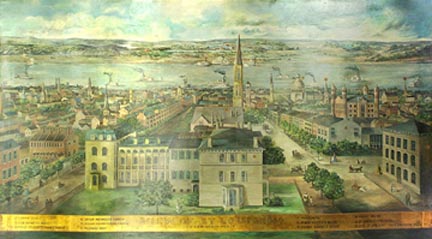

Forests in our region are plagued by
a
number of woody exotic
species: Amur honeysuckle
(Lonicera maackii), Japanese
honeysuckle (Lonicera japonica),
periwinkle (Vinca minor), and
purple-leaf winter creeper (Euonymus fortunei), to name a few.
It is interesting to note that Vinca and Euonymus
are evergreen, while L. japonica is semi-evergreen in our
climate, and L.
maackii (below, right and left) has a very protracted leaf display
(early April to hard
frost in November). Moderate temperatures (Should we say increasingly moderate
temperatures?) during the leafless seasons of early spring and late
fall appear to provide
photosynthetic opportunities not used by native species. Students in
the lab have undertaken an
array of projects concerning these species.
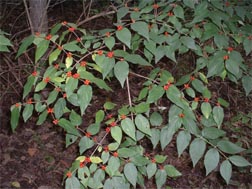 Undergraduate
Audrey Vaughan and her
helpers have
explored how the timing of
radical pruning in
combination with herbicide treatment may be used to kill Amur
honeysuckle. This technique
promises to be quick, inexpensive and effective.
Undergraduate
Audrey Vaughan and her
helpers have
explored how the timing of
radical pruning in
combination with herbicide treatment may be used to kill Amur
honeysuckle. This technique
promises to be quick, inexpensive and effective.
Students
in the new Ecology of Plants
course and undergraduate
students Audra Hoover and
Audrey Vaughan have mapped a series of Amur honeysuckle
populations for
demographic studies.
See these results at
the 2005 Ecological Society of America Meeting, Montreal Canada
New graduate student Gail
Hollis
will be working on a thesis project
examining how Amur
honeysuckle invasions affect the populations of predatory birds.
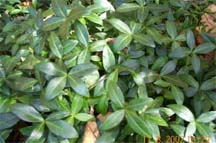
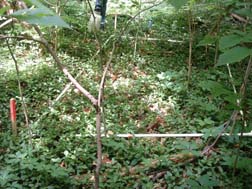
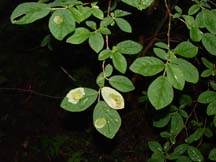 Eastern
leatherwood (left) is an
amazing
plant! Although this very shade
tolerant understory shrub
ranges throughout eastern north America, it is particularly abundant
under closed sugar maple canopies in Upper
Michigan. Imagine: thriving in the "dungeon of forest
understories"! It gets its common name from
the very tough bark that surrounds its light, flexuous stems. The
plant
is quite toxic and has been
examined for a number of useful classes of chemicals. White-tailed
deer, the plague of the eastern
forests, do not eat it.
Eastern
leatherwood (left) is an
amazing
plant! Although this very shade
tolerant understory shrub
ranges throughout eastern north America, it is particularly abundant
under closed sugar maple canopies in Upper
Michigan. Imagine: thriving in the "dungeon of forest
understories"! It gets its common name from
the very tough bark that surrounds its light, flexuous stems. The
plant
is quite toxic and has been
examined for a number of useful classes of chemicals. White-tailed
deer, the plague of the eastern
forests, do not eat it.
The lab has
cooperated closely on
these projects with Dr. John
Zasada (now retired, U.S. Forest
Service, Grand Rapids, Minn.) and Dr. Bill Mattson (U.S. Forest
Service, Rhinelander, WI). Studies undertaken by lab members have
examined a range of issues, from growth responses to in
relation to forest harvest, small scale plant distributions,
herbiviory, and seed production. Recently, graduate student Travis
Burleyson examined herbiviory by Leucanthiza
dircella, a
specialist leafminer, in response to plant spacing across a 30 km
transect in the Ottawa NF,
Michigan. We will continue our studies of herbivory in summer 2005
focusing on the
demographic consequences of herbivory.
Some
abstracts of papers concerning leatherwood presented at
meetings: ESA
2001 ESA
2003 ESA
2004
See our recent paper
on the
seed
production of Dirca palustris:
Journal
of the Torrey Botanical Society Volume 131 Number 4 2004.
Abstract
for podium talk at the 2005 Ecological Society of America Meeting,
Montreal Canada
 In Upper Michigan, canopy openings
created naturally or through
selective harvest are commonly
stocked by dense thickets of sugar maple seedlings. Light levels
beneath these thickets are very
low, and we assume that underground competition is intense as well.
Informal observations
suggest that regeneration thickets reduce the diversity and abundance
of understory herbs. If this
pattern is commonplace, current selective harvest techniques may
"bottleneck" the understory
over the course of 100 years. In a manuscript currently in preparation
we will report on the
results of a large scale sample of natural regeneration thickets in the
Sylvania Wilderness, Upper
Michigan. This work is conducted in collaboration with John Zasada
(retired, U.S.F.S.), Tom
Crow (U.S.F.S), David Buckley (Univ. Tenn.) and Elizabeth Nauertz
(N.P.S.).
In Upper Michigan, canopy openings
created naturally or through
selective harvest are commonly
stocked by dense thickets of sugar maple seedlings. Light levels
beneath these thickets are very
low, and we assume that underground competition is intense as well.
Informal observations
suggest that regeneration thickets reduce the diversity and abundance
of understory herbs. If this
pattern is commonplace, current selective harvest techniques may
"bottleneck" the understory
over the course of 100 years. In a manuscript currently in preparation
we will report on the
results of a large scale sample of natural regeneration thickets in the
Sylvania Wilderness, Upper
Michigan. This work is conducted in collaboration with John Zasada
(retired, U.S.F.S.), Tom
Crow (U.S.F.S), David Buckley (Univ. Tenn.) and Elizabeth Nauertz
(N.P.S.).
ESA 2001 Meeting abstract ESA 2003 Meeting abstract
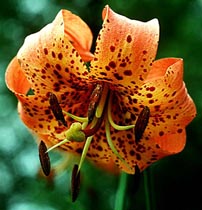
We
are presently getting started on
projects in the northeastern
Ozarks outside St. Louis, MO. Undergraduate Kyle
Lauer completed a
preliminary
vegetation survey documenting tree seedling
recovery after a much needed culling of the Tyson deer herd.
Undergraduate Amber Major is
examining the woody
flora of seeps in the bluffs of this karst region.
Graduate student Dan
Pettus
is working out restoration
techniques for Lilium michiganense (right),
a species nearly extirpated by deer
and perhaps a disrupted fire regime.
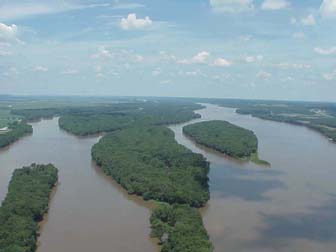 After the Great Flood of 1993 the
lab began periodic sampling of
four forests along the
Mississippi River near St. Lois, MO. Graduate student Charlie Deutsch
is
completing a thesis examining
the recovery of two stands in detail. The study specifically addresses
the very abnormal
hydrology of the region. Headline: Protracted summer floods play havoc
with
seedling establishment, diminishing the diversity of native woody
species to just two, silver maple
(Acer saccharinum) and green
ash (Fraxinus pennsylvanica).
After the Great Flood of 1993 the
lab began periodic sampling of
four forests along the
Mississippi River near St. Lois, MO. Graduate student Charlie Deutsch
is
completing a thesis examining
the recovery of two stands in detail. The study specifically addresses
the very abnormal
hydrology of the region. Headline: Protracted summer floods play havoc
with
seedling establishment, diminishing the diversity of native woody
species to just two, silver maple
(Acer saccharinum) and green
ash (Fraxinus pennsylvanica).
ESA 2001 Meeting abstract ESA 2004 Meeting abstract

The SIUE Campus features perhaps 1000 acres of old field and degraded forest habitat. The region was colonized fairly early in the 19th Century (St. Louis, MO is 20 miles away), and with this much of the local forest has been high-graded or otherwise mismanaged. In a pilot study, the Schulz lab, in conjunction with faculty Dick Brugam and Bill Retzlaf are attempting to replant the extirpated oak-hickory forest that dominated the region. We call this the 200 Pound Squirrel Project because of its decidedly offbeat approach. Guess which one of us best fits the appellation "200 Pound Squirrel!"
Dr. Kurt Schulz
Dept. of Biological Sciences, Box 1651
Southern Illinois University Edwardsville
Edwardsville, IL 62026
Voice: 618-650-3005
Fax: 618-650-3174
kschulz@siue.edu
© Kurt Schulz